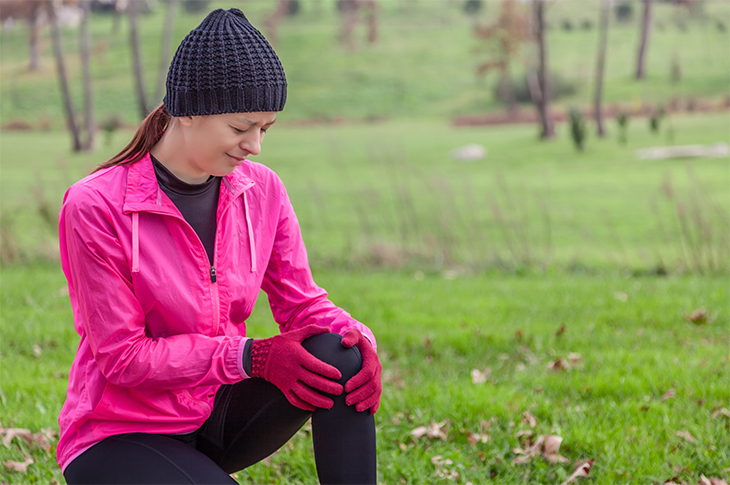
If you love getting sweaty outdoors from spring through fall but lose your passion once sweater weather is in full force, you’re not alone. It can be challenging to find the motivation to keep working out outside when the days are not only shorter but also colder. Suddenly, you’re hitting the snooze button rather than jumping up in the morning to hop on your bike, and midday runs might become teatime to help warm you up in your chilly home office.
Add in joint pain, and you may vow to not exercise outside the house until the frost fully disappears. Anecdotal evidence shows that people who have osteoarthritis believe the weather impacts their pain. Also, colder temperatures can trigger joint pain, swelling, and discomfort, particularly in the knees and hips, for people without arthritis.
You can learn to manage and even prevent cold weather joint pain so that you can keep racking up your running, walking, and biking miles or doing whatever type of outdoor activity you love.
Why Do My Joints Hurt in the Winter?
There’s a clear connection between colder weather and increased joint pain and stiffness. For example, in a 2007 study of people with osteoarthritis published in The American Journal of Medicine, every 10-degree decrease in temperature was linked with an increase in knee pain.
Why this occurs, though, isn’t so clear. One theory is decreased circulation—when it’s cold, “our blood moves from the periphery to important organs like the heart and lungs,” explains Chris Tutt, PT, MS, MBA CEO of ProActive Physical Therapy Specialists. This takes some warmth away from the joints, causing them to feel stiffer.
Another theory is about barometric pressure. “In people with osteoarthritis, the cartilage in the joint is worn away, exposing the nerves underneath,” Tutt explains. Those nerves may pick up on changes in the pressure, and at the same time, inflamed areas of the body—such as the joints for those who have rheumatoid arthritis—swell more when the barometric pressure is low, Tutt adds. It all adds up to pain and discomfort.
Or it may be that we simply tend to be less active in the winter—we don’t need to mow the lawn, and the cold and inclement weather often keeps us inside on the couch. And, even though we may not realize it, any movement in general helps reduce joint stiffness and pain. “A lot of times, those activities we do that help joints and stiffness, we do less of in the winter,” says Jennifer Baima, physical medicine and rehabilitation specialist at UMass Memorial Medical Center.
Although this joint discomfort can happen to anyone, those who are more sensitive to pain, who have osteoarthritis, or who have conditions such as diabetes, heart disease, and asthma—which often make you less active—may be more susceptible to cold weather joint pain, Tutt says.
How to Prevent Joint Pain
Don’t let the fear of joint pain keep you from being active when it’s cold outside. “Even low-impact activities like walking or riding a stationary bike can increase blood flow and the warmth of joints and reduce stiffness,” Tutt says. If you’re concerned about aches, a few things may help head off joint pain or reduce its severity.
Naturally, you could work out indoors. You can find an endless number of free home workouts online if you need inspiration.
But if you want to get out of the house, first up, layer up. Pay particular attention to your extremities, Baima says. Use these tips to winterproof your workouts.
Next, if you have arthritis, consider using a heat pad on your affected joint for no more than 20 minutes before you exercise. “When you are warm, there’s more blood flow to the area, making the joints more extensible and able to move a lot freer and better,” Tutt says.
Then, whether or not you have arthritis, warm up outside for at least five minutes so your body literally warms up. Baima recommends dynamic stretching (such as swinging your leg back and forth and side to side and marching in place while bringing your knee forward and then back as if you are kicking your butt). This will help your body adjust to the temperature.
Also try to pay attention to the weather. “Some people who study this topic think it’s not the temperature but the change in temperature” that increases the risk of joint pain, Baima says. If you notice a big change in the forecast, consider adding or removing a layer, or maybe wearing pants even though you typically run in shorts year-round.
Lastly, don’t neglect your cooldown. “It can make a huge difference in pain,” Baima says. “We are more likely to get injured when we’ve pushed ourselves to the limit. If you go, go, go hard and just stop, it’s harder for your body to transition.” She recommends movements specific to your activity: If you run, jog and then walk for a few minutes, or after a bike ride, cycle at a low speed. (You could also hop on an elliptical or other machine inside if it’s super cold.) After doing that for three to five minutes, try the following sequence from Tutt.
Calf stretch. Stand about 18 inches from a wall. Facing the wall and keeping your back straight, place both hands on the wall and step one foot back in a staggered stance with all toes facing the wall. Keeping your back heel on the ground, bend your front knee until you feel a stretch in your back calf. Hold this stretch for 30 seconds. Then, keeping your heel on the ground, straighten the front leg and bend the back knee until you feel a stretch in your lower calf. Hold this stretch for 30 seconds. That’s one rep. Repeat for a total of 2 to 5 reps on each leg.
Hamstring stretch. Stand about two feet away from a surface that is about a foot to 18 inches tall. Lift one leg and place your heel on the elevated surface. Keep that leg straight, with the toes pointed toward the ceiling, the foot flexed, and your back straight. Lean forward at the hips with your upper body. You should feel this in the back of your leg. Hold the stretch for 30 seconds and repeat for a total of 3 to 5 reps on each leg.
Hip flexor stretch. Stand tall and take a generous step forward with one foot. Bend that knee and transfer your weight onto the front right leg. Continue to lower yourself slowly into a lunge until your back knee is resting on the ground. Staying tall through your back, without bending forward, move forward at your hips. You should feel the stretch in the front of your back leg. Hold the stretch for 30 seconds and repeat for a total of 3 to 5 reps on each leg.
Quadriceps stretch. Stand tall. Bend one knee, bringing your heel to your buttocks. Hold it there with your hand. Place your other hand against a wall for balance. Gently pull up with the hand on your heel. You should feel a stretch in the front of the leg with the bent knee. Hold the stretch for 30 seconds and repeat for a total of 3 to 5 reps on each leg.
How to Manage Joint Pain
If you do everything above and still experience joint pain, there are ways to manage the discomfort, in addition to following your doctor’s advice and recommendation. If you choose to use medication, talk to your doctor about what dosage is best, Tutt says.
While heat is best for stiffness, you want ice for inflammation, Baima says. “Cold also numbs the nerves, helping to reduce pain,” Tutt adds. Apply an ice pack for up to 20 minutes at a time.
In between icing, don’t just sit there. “Any time you are static, that’s when pain and stiffness will start to set in,” Tutt says. He recommends getting up from your desk or couch every 15 to 20 minutes and walking around for a minute or two. (If you’re working from home, consider tackling a quick chore while you’re at it. That will keep you from making one too many stops to the kitchen.)
However, if your pain prevents you from doing everyday activities (such as climbing stairs or getting into and out of your car), wakes you up at night, or does not improve with gentle movement, seek out a physician. There may be an underlying health condition that needs attention.
This information is for educational purposes only and is not intended as a substitute for medical diagnosis or treatment. You should not use this information to diagnose or treat a health problem or condition. Always check with your doctor before changing your diet, altering your sleep habits, taking supplements, or starting a new fitness routine.

If you have questions about a Fitbit tracker, product availability, or the status of your order, contact our Support Team or search the Fitbit Community for answers.
Please note: Comments are moderated and may not appear immediately after submission.